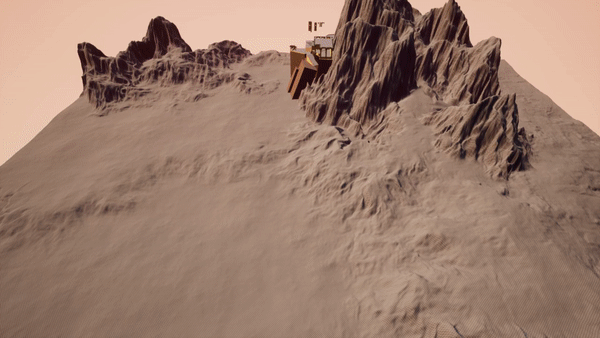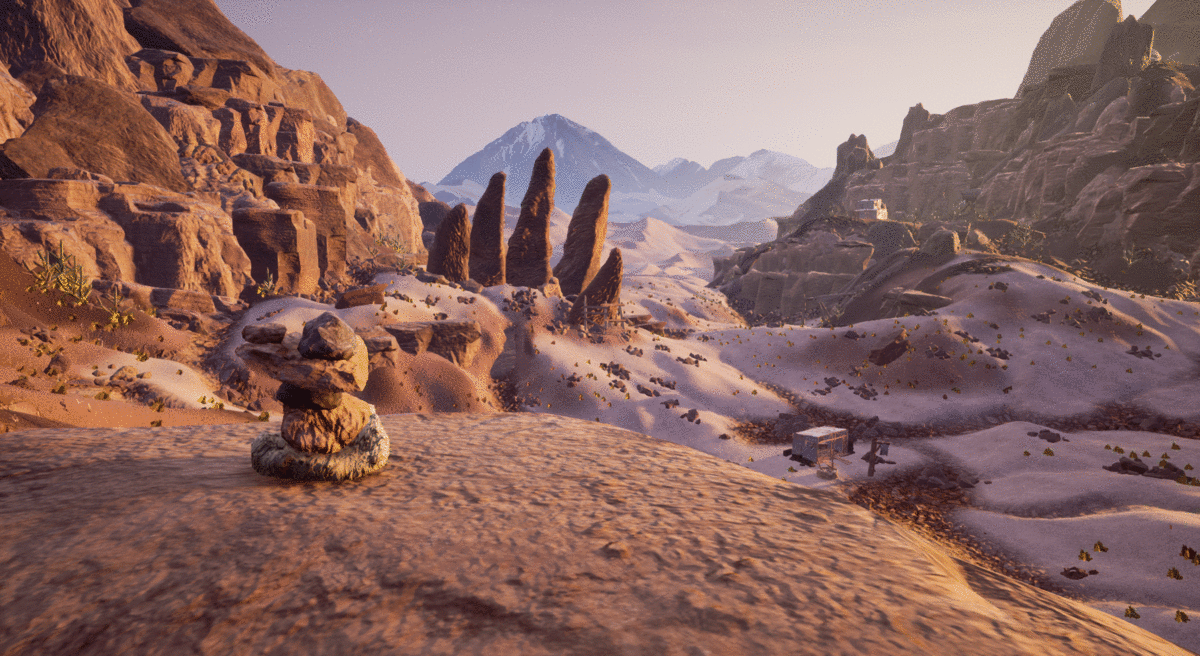Arid
Arid is a gritty, exploration-survival experience that challenges players in surviving the driest place in the world. By using your skills and adaptation, you must face the loneliness, the extreme temperatures, and the mysteries of the Atacama Desert.
Main Role: Level Design
Secondary Roles: Set dressing & Optimization
Timeframe: 32 Weeks
Platform: PC & PS4
Team size: 22
Software used:

Houdini

Jira

Unreal Engine 4

Perforce

G-Suite
Main Responsibilities
--------------------------------------------------------------------------------
-
I created core-level design documentation to keep a consistent vision.
-
Planned all level content using references, mood boards, and research.
-
Created a vertical slice to present the concept to a team of stakeholders.
-
Sculpting the open-world terrain and define play spaces and the edge of world.
-
The introduction and onboarding to the game mechanics.
-
Implementing resources, repairable objects, recipes, and objectives.
-
Optimization of the world and performance-boosting to push for a ps4 compatible build.
Pre-Production Phase
Research
Starting off the project I did a lot of research regarding a wide variety of things. Topics ranged from basic knowledge like; Common survival game tropes and open-world level design pipelines, to more focused research like; Setting up a Point of Interest and Plants in the Atacama. Research was mostly done by playing reference games and reading articles, books, etc., and I wrote a few documents to share my findings with the team.

Gameplay prototype
In collaboration with the entire design and programming team we made a proof of concept project in which we tested and experimented with our planned gameplay loop and the mechanics we used for it. Personally I was involved in designing and scripting prototypes for mechanics, creating the base terrain and shelter blockouts, implementing all features into one whole and creating the overall level flow.

Build language
Since we planned to go work with stone ruins, I researched all the architecture in and around the Atacama desert. I recreated (and gamified) one of our main references using Unreal Engines BSP system and implemented it in the scene. Creating the blockout has helped us a lot with looking for the right metrics, establishing a build language and give the artists a reference for production time.

Blockout

Structures
For the structures in my part of the map we wanted to go for old temples and ruins that are partially broken and decrepit. After a few failed attempts and continuous research we ended up downscoping the area, so we could finish the rest of the map in the timeframe we had.
We made a small modular kit of walls, doorways, stairs, etc. that could be used anywhere in the map to make interesting and unique locations.

Environment
To create the terrain we used a basic Unreal terrain which we used as input for a Houdini Engine tool that was being made by one of our artists. One of the bigger struggles this project was finding a good balance between generation and control.
To get a workable terrain tool we had to put great collaborative effort into ensure the terrain looks good and is workable by the level design team.
Level progression

One of the most exiting things there is as a level designer is seeing your levels evolution over time. The gif above gives a great overview of how the level evolved by doing iterations, applying new generations, getting new tools and implementing Points of Interest and interaction.
Onboarding
Planning
Being responsible for the onboarding of the game I had a lot of planning to do as well as research. Because it was essentially a new level I had to properly identify, concept and plan the new area. The biggest challenge was finding ways to introduce and teach players about hidden or environmental mechanics.

Objectives
For the onboarding section I requested features to help me with teaching the players what they need, these features were inspired by reference games that we researched in the planning phase. Working with the mission was quite challenging and one of my biggest mistakes was requesting the missions system before fully figuring out the flow on paper, resulting in a system that didn't compliment what I had planned.

Player guidance

In a semi-open world game like Arid it was very important for us to have ways of guiding the player to the key locations. During the planning phase I planned in Vista's and Landmarks to do the big scale guidance. Later in the process we also used bread crumbing for the smaller scale guidance.
Optimization
Foliage
One of the challenges we gave ourselves for this project was to make all of the foliage interactable. After I found a foliage replacer plugin, I collaborated with the programming team to implement the plugin, modify it to our needs and optimize it to get the best result we could.
(bit hard to see what happens in the video, but essentially it shows that the tool dynamically changes the static mesh foliage into an actor once the player get's in range)
Level of Detail
A chunk of my time has been spend optimizing assets. I found and utilized store bought plugins to efficiently mass produce the LoD's for the environment. Besides that I also optimized assets through custom collision and custom distance settings to get the optimal result for strong performance.

More to be added soon!
Since the project is currently still ongoing there will be more
content added in the near future!
Personal Post-Mortem
Other Projects
My stance in the project:
As the one responsible for the onboarding level and the first level, my impact on the project was quite substantial. I was a very active member in the team and contributed actively to the overall concept and issues that arose. I worked on Arid with great joy and learned a lot!
My biggest mistakes:
During the entirety of the project I lacked in my engagement to get feedback or help from my peers. This caused me to have less direction during iteration and sometimes be overloaded with tasks. In the future I should reflect more on my progression, and plan my hours more strictly to avoid having too many tasks piled up.
My best learnings:
Arid was my first experience working on an open world game, and also working with a bigger team that works towards an actual release. I've learned a lot about leading the player through passive clues, how to reward explorative behavior and prepare the level for people that try to break the game. Besides that I've learned lots about optimizing assets and the scene. I've also learned to be more proactive in solving issues, and make replacement content for content that gets cut.





